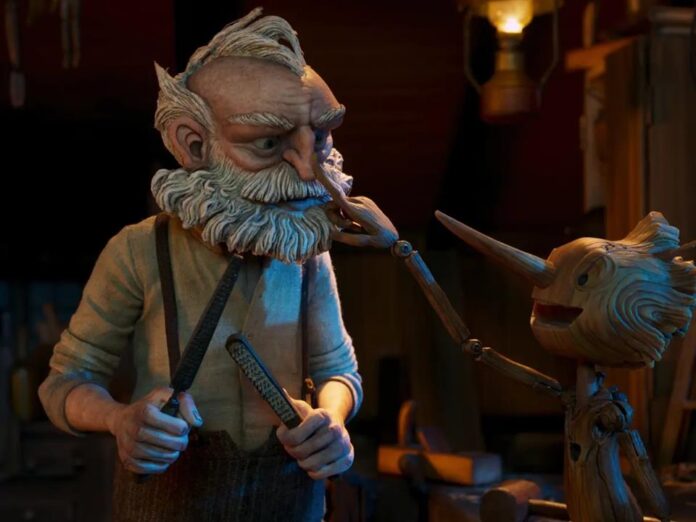Guillermo del Toro’s Pinocchio. Who’s idea was this? Who’s to blame? I am a firm believer that great art makes a name great, but that a great name does not default to great art. It’s disheartening to me when I have to make a review like this one, where my disappointment was completely unexpected. I remember being 12 and curling up on the sofa under a blanket, turning all the lights off in the basement, and turning on Pan’s Labyrinth for the umpteenth time, as this was my ritual when I could not sleep. From Hellboy to The Shape of Water, a del Toro film, was always, for me, an easy homerun. So what happened here?
Well, first I want to note that the technical aspects were top-notch: the execution was flawless, the animation was breathtaking, and the characters came to life. The stop-motion was above any expectations I had going in. It wouldn’t be del Toro if the overall look was not creepy; unfortunately this is where part of the problem came in for me. Guillermo del Toro has a unique type of creepiness that shines through all of his works, but this creepiness is not transferable to children’s films or stories; he’s not Tim Burton. And I’m not saying Tim Burton is better than del Toro, what I am saying is they are different kinds of creepy that don’t transfer with each other. I would not want to see a Tim Burton rendition of Hellboy, just as much as I regret watching a Guillermo del Toro’s rendition of Pinocchio.
Character-wise I had issues with a lot of them. The first and most frustrating was Geppetto’s age. We see, in total, over 30, maybe even 40 years of his life within the movie, and from his youngest to his oldest self he looks like a centenarian. Secondly, Pinocchio himself was annoying and hyperactive to an extent that surpassed childlike innocence, or curiosity. Next there was Jiminy Cricket (or Sebastian J. Cricket in this case), who could not string a line together as his body was being abused for the purpose of slapstick comedic relief.
There is one character, however, that intrigued me and left me wanting for more, and his name was Candlewick. In the span of five scenes, Candlewick’s relationship with his father told a story of its own, with character growth, conflict, and a climactic resolution. It was unfortunate to see so little of him as he possessed the dimensions and complexities Pinocchio and Geppetto lacked.
The last disappointment for me was the story itself. I feel like the message was lost. At one point it seemed to be a story about the preciousness of life in its finite form. At another, it seems to be about the complications and nuances in the relationship between a father and his son. Yet it then becomes a forceful caricature of facism, whilst still being a story on self-acceptance. If you are reading this and thinking, That doesn’t sound too bad, I would usually agree, but it feels like this movie would have to be a series for all these messages to come out clearly. The shortness of a movie made them muddle and mix into a confusing point, which in the end made it feel like nothing was of consequence.
I really wanted this to be a project that succeeded but alas, for me it fell flat. It’s a children’s movie that is not for children, with adult themes that are simplified to a child’s understanding. In the end it is a movie I would not recommend for either child or adult. I would however, recommend it for any animation/stop-motion enthusiast and as a study piece for art students.


